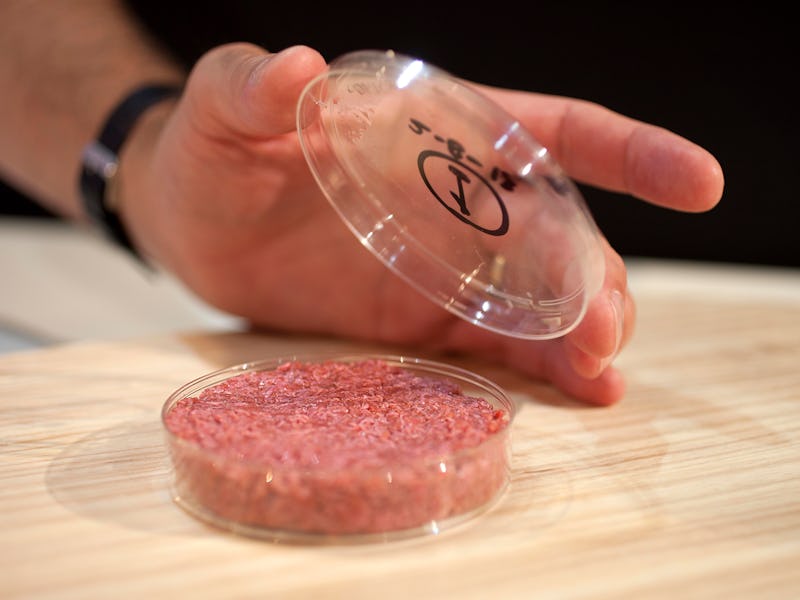Lab-Grown Meat: Will the Booming Industry Help Benefit the Environment?
The Good Food Institute has found the industry explode in size.

The lab-grown meat industry saw rapid growth over the course of 2018, paving the way for an alternative to farmhouse slaughter which would dramatically cut back on carbon emissions. Estimates suggest these meats could reach a mass market by 2025, welcome news as evidence continues to mount that transitioning humanity to a more plant-based diet might be a necessary step toward averting widespread ecological disaster.
Ventures devoted to the nascent area, which involves producing meat from animal cells in a lab instead of rearing and killing livestock, raised a total $50 million in capital investment in 2018. That’s double the total amount the industry has raised since it first began going commercial in 2015, bringing the total investment to $73.3 million.
That’s according to the Good Food Institute, a Washington, D.C.-based nonprofit that advocates for both cell-based alternatives to animal products as outlined above, as well as totally plant-based alternatives like the Impossible Burger. The institute released a report Monday showing how both industries have grown over the past year.
“These industries are accelerating rapidly, and we are about to see them take off,” the institute’s director of innovation Brad Barbera said in a statement.
Why Fake Meat Is an Environmental Issue
Better fake meat could mean big benefits for global emissions. A 2018 report from the same institute found that feeding meat-eaters using “clean beef” grown in a lab could reduce greenhouse gases by between 74 to 87 percent relative to traditional beef farming methods. It could also use more than 95 percent less land, and reduce nutrient pollution, where fertilizers wash into bodies of water and kill marine life, by 94 percent. In the case of chicken, cell-based growth can use up to 67 percent less land.
Lab grown meat is made by taking animal stem cells used to build new cells and encouraging them to grow by placing them in a nutrient liquid. The process does not inherently require killing an animal, though the practice has sparked religious and ethical debates about whether it counts as meat.
The process as explained by the GFI.
The industry has come a long way since Mark Post first ate a lab-grown burger in 2013. That slice of meat, a five-ounce burger created from 20,000 strips of muscle cell, cost an eye-watering $325,000 to make. By 2015, that price had dropped to just $8.15. Firms like Memphis Foods are working on beef and chicken, Finless Foods is working on fish, and Wild Earth has even begun exploring how to make lab-grown mice to feed cats.
It may not be long before these meats reach the dinner table en masse. The Good Food Institute senior scientist Liz Specht claimed in a February report that lab-grown meat will have already reached price parity with traditional meat once it is produced at scale. Kristopher Gasteratos, founder of the Cellular Agriculture Society cell-based agriculture lobby group, told ABC News in May 2018 that it could reach a mass market by 2025. Researchers focused on bioreactor technology stated in 2016 that they want lab-grown turkeys on American Thanksgiving dinner tables by 2030.
Some researchers have drawn lab-grown meat’s green credentials into question. A team from the University of Oxford noted in February that cows produce nitrous oxide and methane, while growing meat in a lab may produce carbon dioxide to power the lab’s energy. Methane is a lot more destructive per tonne on the atmosphere, but unlike carbon dioxide its effects dissipate after around 12 years, making its impact on the planet a more short term concern.
Even Post, one of lab-grown meat’s biggest proponents, readily admits that the product is more of a stop-gap to lure a still largely-meat eating population in a more sustainable direction. In 2013 he told the New York Times that “vegetarians should remain vegetarian. That’s even better for the environment.”
There’s a lot of unknowns around lab-grown meat, for example its annual demand and what its energy usage will look like as production ramps up. With the rapid pace of development seen so far in the industry, it may be only a matter of time before more research emerges around this potentially eco-friendly alternative to the current meat industry.